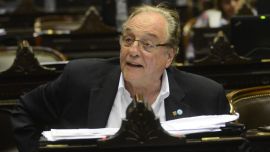With 60 percent of the nation’s electricity currently coming from fossil fuels, the national government is seeking to encourage a renewable energy revolution, after years in which Argentina has lagged behind in the sector. But the change, officials are finding, is far from easy. Targets have been missed – and it looks like this year’s one will be too.
Many new projects are already on the way. The government has set an ambitious target pushing for renewables to account for 20 percent of the entire energy matrix by 2025.
But despite the push for renewable energy in Argentina, new developments have been paired with the less ecofriendly development of shale gas and oil in the Vaca Muerta area. The site, a giant deposit of non-conventional hydrocarbons that spreads across four provinces (Neuquén, Mendoza, Río Negro and La Pampa), is a long-term investment, but it is also one that could lock the country into a fossil fuel infrastructure, complete with the accompanying greenhouse gas emissions, for decades to decades to come.
Such a move would have a significant impact on Argentina’s emissions – the energy sector currently represents 52.5 percent of the greenhouse gases the nation pumps out into the atmosphere.
Experts say pollution levels are key.
“Argentina was one of the last countries to enter into renewables, but because of that it already knows what works and what doesn’t. Now the challenge ahead is planning to pollute less,” Marcelo Álvarez, head of the Chamber of Renewable Energy (CADER), told the Times in an interview. “Our exports could end up being penalised because they are energy-intensive and have a larger carbon footprint.”
CHALLENGES
The country has had a hard time shifting toward renewable energy. Currently, it represents less than two percent of the total electric grid, which is made up of 64 percent thermal power plants fuelled by oil or gas, 30 percent large hydroelectric plants, and four percent nuclear power plants, according to official data.
Back in 1998, a law declared renewables a subject of “national interest” but the 2001 economic and political crisis destroyed the financial incentives laid down for adopters in law. Later, in 2006, a second law set a target that eight percent of the energy matrix be based on renewables by 2016. Again, problems with financing made the target impossible to achieve.
Could it be a case of third time lucky? New legislation was assed in 2015, crucially by a consensus vote. The law created tax and customs incentives for renewable projects and established, once again, a target for renewable energy to make up eight percent of the matrix, this time by 2017. This, however, was not met, casting doubts over the law’s second 20-percent target, set for 2025.
“The eight percent [target] won’t be achieved this year either. Maybe in 2020, if it all goes well. [But] it’s something normal, the country is on a learning curve on renewables,” Juan Bosch, head of the energy trading company SAESA, told the Times. “The change carried out in renewables [so far] is outstanding, but the government could have given more freedom to the private market and created more trust.” Through the latest law, the Mauricio Macri administration has held tenders and signed contracts with private investors between 2016 and 2017 for the construction of 147 renewable energy undertakings, with a total capacity of 4,466 megawatts (MW) in 22 of the country’s 23 provinces. The vast majority of these projects involve wind (2,466 MW) and solar (1,732 MW) power.
The contracts were signed as part of the RenovAR energy bidding programme, through which the government expects to receive US$15 billion in investment and reduce greenhouse gas emissions by 79.64 million tCO2 by 2020. RenovAR has already held three tenders (1, 1.5 and 2) and will likely go for its fourth one in the second semester of the year.
Construction has already begun in some projects, with some starting earlier than planned such as Nonogasta in La Rioja and other delayed such as Cauchari in Jujuy. Overall, the projects will make a significant contribution to an electric grid with an installed capacity of around 30,000 MW, already at its limit and not meeting the growing demand.
The Times reached out to the Renewable Energy Under Secretariat to gauge their take on the situation, but they refused to comment.
“There are projects with different status, some that can’t take off and others that are doing well. The main problem is the funding needed for their construction,” Ramiro Algacibur, head of Incaica energy consultancy, told the Times. “Most of the projects will end up being carried out.”
Ezequiel Mirazón, Energy, Utilities and Mining Leader at PwC Argentina, agreed and though there have been “some delays” in the implementation of the projects that have been reported, he praised the government’s strategy of gradually launching tenders.
“It allows to have lower costs as time goes by,” he said.
Investing in renewables isn’t cheap and it depends on the type of technology chosen. For example, installing one MW of solar energy power can mean an investment between US$800,000 and US$900,000, a figure that can reach US$1.3 million for wind power. However, the firms don’t have to put up all the capital – part of it is provided by the companies allocated the project, another part by financers such as the World Bank.
There’s another flip side too – once installed, a renewable energy project can generate much cheaper energy than that produced by fossil fuel plants, meaning lower energy bills.
Argentina has a large wind potential in Patagonia, solar potential in the North and many resources for biogas and biomass in agricultural-based provinces. But it has a lot of catching up to do compared to its Latin American neighbours – Uruguay has 44 percent of its energy matrix based on renewables, followed by 18 percent in Brazil and 17 percent in Chile. Food for thought.
SELLING YOUR ENERGY
It’s not only energy companies that are doing their part to push for renewable energy – individuals are too. Under the law, citizens are now entitled to generate their own energy through clean sources and incorporate surpluses into the public grid.
A law was passed in November with the aim of encouraging the generation of and incorporation into the grid of renewable energy by individuals and private actors, in what is known as distributed, dispersed or decentralised generation.
“It’s something disruptive, it changes the way energy is generated and distributed,” Juan Carlos Villalonga, a Let’s Change lawmaker and one of the authors of the law, told the Times. “It brings challenges for the distribution sector, but it can have a strong positive effect on regional economies.”
The law requires that power companies “facilitate the injection” into the grid of surpluses that individual consumers may generate, and it prohibits companies from making any additional charge for doing so. Nevertheless, the law is yet to be enacted and all provinces will be required to authorise it first.
Whoever adds energy to the grid will not obtain money for the energy they sell, but they will be instead compensated by the relevant company with discounts in subsequent billings. The law creates a public fund to encourage its development, which the government is to set up with about US$95 million of its own funds.
“It’s a paradigm shift. Energy distribution companies are worried to earn less because of the law and are trying to disincentive consumers from putting their own solar panels,” Bosch argued. “The law creates challenges, but they can be solved while it starts to be implemented.”
The attempt to fundamentally change the role and perception of renewables in Argentina comes as the country faces a crisis in its energy sector, a fact acknowledged by the Macri administration.
During the coldest days of winter, when residential systems increase consumption of natural gas, up to 30 percent of the gas consumed is imported, according to data from the Energy and Mining ministry. At the same time, in summer, Argentina buys up to 10 percent of the energy used from Brazil, Paraguay and Uruguay.
Energy experts agree that the push for renewable energy can’t be done any faster, especially because of the limitations on funding and on the transmission lines, an argument rejected by environmentalists.
This is where the discussion over Vaca Muerta comes in.
The 30,000-square-kilometre area accounts for one of the largest shale oil and gas reserves in the world and it is where the government has high hopes for the energy sector.
“The country has a massive energy deficit and we have to take advantage of renewables and Vaca Muerta at the same time. It would be a mistake to start a competition between both,” said Mirazón.
The Macri administration expects investments of up to US$15 billion this year in Vaca Muerta and is spending billions in subsidies to encourage production. Last year, US$4 billion were spent to encourage natural gas extraction and a further US$1.9 billion to boost oil extraction, according to a report by OPSur.
“The government’s energy policy is to invest in renewables and in fossil fuels at the same time. The resources of Vaca Muerta should remain in the ground for environmental and economic reasons,” Ingo Boltz, a member of the energy campaign of Greenpeace Argentina, told the Times.
“It’s a bad investment. The country’s matrix should move towards renewables as soon as possible. Spending more in renewables means more jobs in the future and no dependence on oil companies. That’s the real energy autonomy.”


























Comments